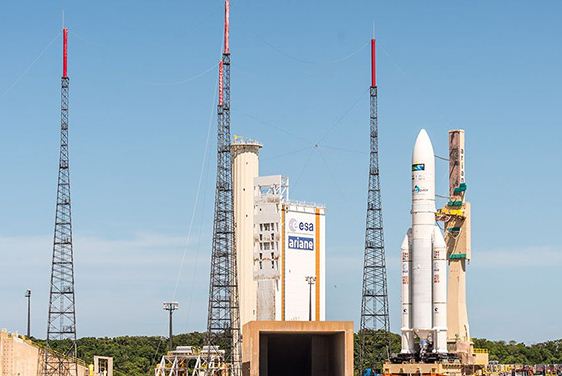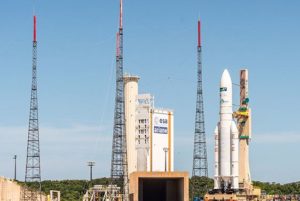India’s latest communication satellite GSAT-18 was successfully launched by a heavy duty rocket of Arianespace from the spaceport of Kourou in French Guiana.The spacecraft and launch service cost about US$153 million.
About GSAT 18 :
India’s latest communication satellite, GSAT-18 was inducted into the INSAT/GSAT system from Kourou, French Guiana by Ariane-5 VA-231. Weighing 3404 kg at lift-off, GSAT-18 carries 48 communication transponders to provide Services in Normal C-band, Upper Extended C-band and Ku bands of the frequency spectrum. GSAT-18 carries Ku-band beacon as well to help in an accurately pointing ground antennas towards the satellite.
- GSAT-18 is designed to provide continuity of services on operational satellites in C-band, Extended C-band and Ku-bands. GSAT-18 was launched into a Geosynchronous Transfer Orbit (GTO) by Ariane-5 VA-231 launch vehicle. After its injection into GTO, ISRO’s Master Control Facility (MCF) at Hassan took control of GSAT-18 and performed the initial orbit raising maneuvers using the Liquid Apogee Motor (LAM) of the satellite, placing it in circular Geostationary Orbit.
The designed in-orbit operational life of GSAT-18 is about 15 years.
- Launch Mass: 3404 kg
- Mission Life: About 15 years
- Power: 6474 W from Solar arrays, Two 144 Ah Li-Ion batteries and Ariane-5 VA-231
- Type of Satellite: Communication

- Manufacturer: ISRO
- Owner: ISRO
- Application: Communication
- Orbit Type: GSO
The satellite was launched aboard an Ariane 5 ECA rocket from the Guiana Space Centre in Kourou, French Guiana.
- The launch vehicle inserted the satellite into a geosynchronous transfer orbit, and once in service it will occupy the orbital slot at 74° East longitude.
- GSAT-18 was originally scheduled to launch on 12 July 2016 alongside Japan’s Superbird-8 satellite, but a shipping mishap which damaged Superbird-8 forced a delay in the launch schedule.
- Arianespace later paired GSAT-18 with Australia’s Sky Muster II for a 4 October 2016 launch. The launch was delayed 24 hours to 5 October due to excessively high crosswinds at the launch site.
About French Guiana Space Centre :
The Guiana Space Centre or, more commonly, Centre Spatial Guyanais (CSG) is a French and European spaceport near Kourouin French Guiana. Operational since 1968, it is particularly suitable as a location for a spaceport as it fulfills the two major geographical requirements of such a site
- It is quite close to the equator, so that the spinning earth can impart some extra velocity to the rockets for free when launched eastward, and it has uninhabited territory (in this case, open sea) to the east, so that lower stages of rockets and debris from launch failures cannot fall on human habitations.
- The European Space Agency(ESA), the French space agency CNES (National Centre for Space Studies), and the commercial companies Ariane space and Azer cosmos conduct launches from Kourou. This was the spaceport used by the ESA to send supplies to the International Space Station using the Automated Transfer Vehicle.
- The location was selected in 1964 to become the spaceportof France. In 1975, France offered to share Kourou with ESA. Commercial launches are bought also by non-European companies. ESA pays two thirds of the spaceport’s annual budget and has also financed the upgrades made during the development of the Ariane






